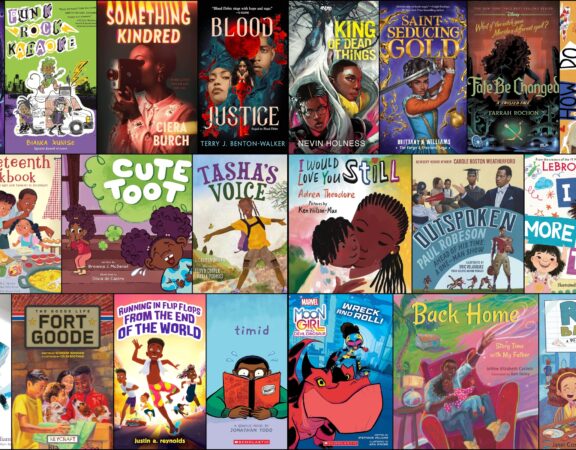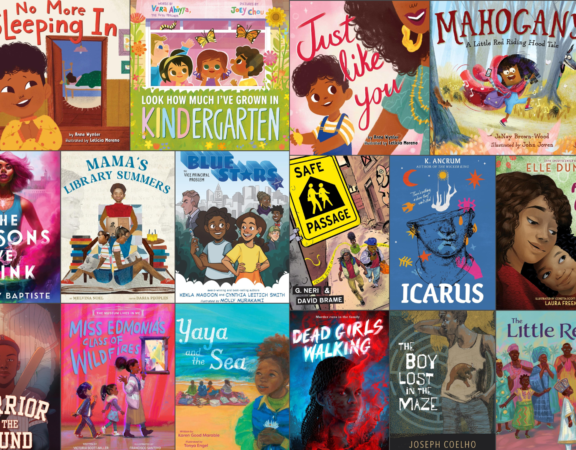Especially for Ours (EfO) is a new blog series. The title is taken from a W.E.B Du Bois’s quote about The Brownies’ Book, a magazine created for African American children during the Harlem Renaissance. Du Bois expressed that The Brownies’ Book was “for all children, but especially for ours.” We believe that the Black book creators spotlighted in EfO share that sentiment about their stories and art. EfO will feature a brief review of the book and an interview with the author or illustrator.
Poets and sisters Aracelis Girmay and Ariana Fields collaborated on the picture book What Do You Know? Girmay is the author of three books of poems and the editor of How to Carry Water: Selected Poems of Lucille Clifton. Her debut children’s book, Changing, Changing: Story and Collages was released in 2005 (George Braziller Inc.). WDYK? is Fields’ debut as an author and illustrator.
This is Part II of their interview discussing What Do You Know? If you missed Part I, you can read it here.
—There are so many gems in WDYK? for educators and students in all grades. Do you have any suggestions on how to approach the themes?
ag: Thank you so much. In a way, this question connects so deeply to your last question. It makes me think of Pablo Neruda’s astounding Libro de las preguntas / The Book of Questions. The questions of this book are so gorgeous and lyrical. They are capacious, unanswerable, serious, playful, strange. Here is one: “Dónde dejó la luna llena / su saco nocturno de harina?” (Where did the full moon / leave its night-sack of flour?) And another one: “Si se termina el amarillo / con qué vamos a hacer el pan?” (If the color yellow runs out, / what will we use to make the bread?) Years ago, I brought a selection of these to second and third graders. I asked them to answer these unanswerable questions and then to ask their own unanswerable questions. I love that to encounter and engage with these questions is to surrender the notion of mastery and to instead think playfully and associatively. To wonder toward surprise. Children were not only excited to share what they stumbled upon but were also excited to hear their classmates’ discoveries.
One of my deepest hopes for our book is for readers to carry this same feeling of unending wonder into poems, drawings, or projects of their own. My hope is that readers might come up with their own possible responses for what the land might say when asked what it knows or loves. My hope is that readers might come up with questions of their own and might imagine that they could ask a question of any being, and that every being has a history, a story, and that all our stories, in some way, touch.
af: Yes! I’d also say: Approach the themes as you are. Add to them, take away, imagine, and know that the answers in response to the question “What do you know?” are limitless.
—This blog feature is called “Especially for Ours.” What do you especially hope for young Black readers who read your book?
af: I hope for young Black readers to feel inspired and know how important, beautiful, and courageous their stories and their (our) elders’ stories are, and to hold dear the history of our connection to each other and all the elements of this earth that we’ve worked with to survive and succeed. That they are the universe. I hope for young Black readers to feel the courage to express what they love and know and to feel encouraged, seen, and reflected.
ag: I love what you say, Ariana. And I love the name and history of this feature, Stacy. I am honored for our book to be a part. I echo what Ariana says. Completely. And I will only add a few things. I hope that young Black readers can sense that this book knows what is true but what not all people and books know: that they and we, as Black people, are here and at home on the earth—the earth of this book and the earth spinning in the vast, black universe. I also hope that young Black readers will read these pages and feel that they are respected, appreciated, loved. That they are known, remarkable, capable, and vaster than language. I hope that these young Black readers will know that we are eager to read, hear, see, and experience their dreaming, stories, and efforts. And we need them. Everyone.
—Are there any future joint or individual children’s projects in the works?
af: For me, I’ve been focusing on garden projects. But in my spare time, I am drawing and working on a story that has been behind the scenes in my mind for a while, so I definitely hope so in the future! I’ve been trying to figure out how to breathe life into it on paper.
ag: I’m so excited to see what this becomes, Ariana.
As for me, I am really excited to be working on another picture book with Enchanted Lion, this one illustrated by Diana Ejaita, whose work astounds me. We are still relatively early in the project. It is an original story about a boy and his grandmother and the moon. In it, we are thinking about place, loss of place, survival, and the African diaspora. It feels to me like a folktale inspired by very specific legacies and histories.
What Do you Know?
Aracelis Girmay | Ariana Fields | Enchanted Lion Books | August 2021 | PB | 56 Pages | Amazon | Bookshop | IndieBound
Connect with Aracelis Girmay on Twitter
Connect with Ariana Fields on Instagram
If you believe BCBA provides a valuable service, please take a few minutes to donate and support our mission to promote awareness of children’s and young adult literature by Black authors.
Amazon/Bookshop/IndieBound Disclosure: BCBA is a participant in the Amazon, Bookshop, and IndieBound Affiliate Programs. The affiliate programs offer participants the opportunity to earn fees by linking to Amazon, Bookshop, and IndieBound websites. Clicking on the book links will direct you away from this site. Thanks for your support!






